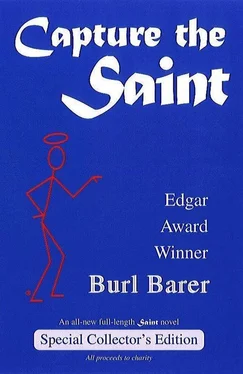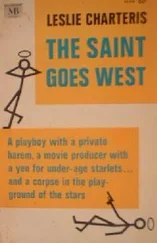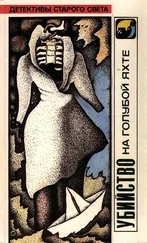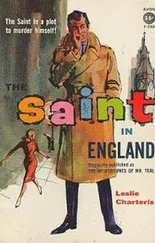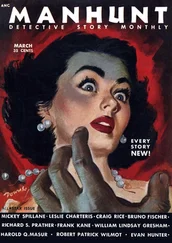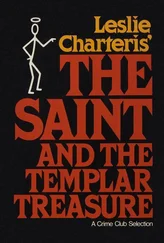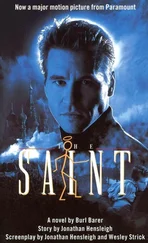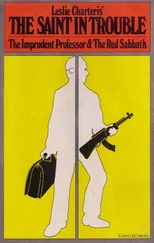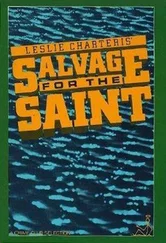Burl Barer
Capture the Saint
Chapter 1
How Simon Templar Spoke of Skiffs, and Salvadore Alisdare Became Agitated.
“Why are you still alive, Mr Templar?”
Simon Templar, alias the Saint, was only momentarily taken aback by the one unrehearsed question posed by perky television talk-show host Connie Cain during the live afternoon broadcast of “Coffee with Connie,” Seattle, Washington’s most popular local program.
“Mythological characters such as myself seldom age at the going rate,” responded the Saint cheerfully. “And if survival is the topic,” offered Simon, “I have been shot at, shackled, handcuffed, gassed, and interviewed by trained broadcast journalists — the relative degree of danger inherent in each being open to debate.”
The small studio audience laughed warmly and applauded with approval as the mildly bemused and professionally coiffed hostess signaled for a commercial break.
“You are very good at this, Mr. Templar. Do you do a lot of television?” Her question seemed curiously genuine in contrast to the alternately sanguine and saccharine couching of her on-air delivery.
“I find precious little on television worth watching,” stated Simon with disarming honesty. “But this is more fun than being either shackled or gassed, although I was once grilled for information under lights almost as intense as these.”
“Did you talk?”
“Not a word,” confided the Saint in hushed tones of mock severity. “Of course, the unsavory individual asking the questions was sadly bereft of your charm, grace, and intrinsic allure.” Simon may have been overdoing the charm, but the studio audience enjoyed the banter.
“When we come back from the commercial,” Ms Cain did her best to avoid a slight blush, “we’ll talk about the movie.”
The movie to which she referred was about to have its auspicious Seattle premier, and while the career of Simon Templar was once as well known as any celluloid adventure concocted for any contemporary hero, it was not a fictionalized version of the Saint’s life that had received the Hollywood treatment.
The simple truth is that Barney Malone, semi-retired Hollywood producer and established acquaintance of the Saint, spent a year on his knees and several hours in a bar convincing Simon Templar to sell him the movie rights to ‘The Pirate’, the Saint’s singular excursion into the world of adventure fiction. Written decades earlier and now creaking with age and bending under the weight of unintentional anachronisms, the novel was at best a derivative pot-boiler distinguished only by the romantic escapades of its Hispanic hero.
The initial sales of ‘The Pirate’ had been more than respectable, an adjective never utilized in the descriptive prose published by the world’s press when documenting the extra-legal activities of its youthful author who, at the time of its original publication, was earning his international reputation as the Robin Hood of Modern Crime.
The fact that a tag-team of screenwriters had rendered the plot and characters of Templar’s original story unrecognizable did not surprise him.
“I lost faith in films about the time of The Falcon,” admitted the Saint to Malone in only half jest. “I have far more faith in the stability of the dollar and the morality of Monarchs.”
The dollars Simon Templar was earning from Malone’s cinematic adaptation were more than enough to prompt the Saint to sit under the hot lights of a television studio, banter with entertainment page pundits, and spend a few pleasant days traveling the West Coast at Malone’s expense to promote the film’s debut.
To those who follow the career of Simon Templar, it may seem tragic that the exploits of the Twentieth Century’s Brightest Buccaneer would be relegated to the entertainment pages rather than dominating the headlines. The Saint was perfectly pleased to be absent from the latest Seattle headlines — a front page story detailing the death by gunfire of a weasel-like miscreant who most often utilized the moniker Salvadore Alisdare. Simon Templar, the affable and entertaining talk-show guest was the exceptionally singular twist in the story; the one missing piece neither police nor reporters were ever able to place.
Simon Templar was not the last man to see Alisdare alive. That doubtful honor was reserved for the individual who, meeting him in a Madison street alley during morning’s wee hours, punctuated the climax of their distasteful conversation by puncturing Alisdare’s lungs with several slugs from a .38 revolver. The Saint saw both men prior to their eventful convergence, knew the outcome of their meeting long before reporters detailed the events in print, and was not the least surprised to read of Alisdare’s death nor the subsequent arrest of the cold blooded killer. Although he encouraged the first’s demise and arranged the second’s arrest, the Saint’s primary intention was a unique and memorable birthday surprise for Barney Malone.
As the historic pleasure craft “Thea Foss” passed under Lake Washington’s Evergreen Point Bridge uniting Seattle with the Eastside suburban communities of Bellevue and Kirkland, Barney Malone raised a small green bottle of Perrier above his sunburned, balding head. “To ‘The Pirate’,” Malone offered as a proud if not predictable toast.
“To Thea Foss,” countered Simon holding aloft his Peter Dawson. “And her memorable motto, ‘Always Ready’.”
“What was she, a Boy Scout?”. Malone’s dark eyes darted about as if anticipating a vaudeville audience’s response from the nearby seagulls.
“The Scout motto is ‘Be Prepared’,” Simon corrected cheerfully. “A subtle difference and subtlety was never your strong point.”
Malone, bedecked in blue Dockers and matching windbreaker, sat back in the yellow canvas deck chair and studied the bronzed features of his long time acquaintance.
“OK, Simon. I know you’re up to something. What’s the story?”
“Let’s begin back in 1889.” The Saint leaned back comfortably and tilted his head to catch more of the sun on his already tanned face. “Dear old Thea Foss was living on a houseboat in Tacoma when a neighbor sold her his skiff for five bucks.”
“Wow. I am really enthralled now,” Barney faked a yawn. “When does someone get shot? If someone doesn’t get shot it won’t make a movie.”
“Hollywood has rotted your brain,” observed the Saint as if he had only that moment discovered the obvious. “Next you will be telling me about past-life lovers and the ancient ascended masters.”
“The only ascended masters I know are DeMille, Hitchcock, and the guy who made King Kong,” countered Malone proudly, “And if I had past lives worth remembering, they would have been on the Late Show by now, and colorized.”
“Thea Foss has been on the Late Show, except she was called ‘Tug Boat Annie’.” Simon waited for the anticipated reaction.
He didn’t have to wait long.
“Tugboat Annie!” Malone was instantly animated.
Sitting bolt upright with a suddenness that almost upended his deck-chair, Malone’s voice increased in volume by several decibels. “Marie Dressler, Wallace Berry... wait, don’t tell me the director...”
The mere mention of old movies activated a hidden circuit in the mind of Barney Malone. His otherwise adult and cynical nature defered to a markedly more youthful demeanor, exulting in the ability to recall with near total precision the cast and credits of innumerable Hollywood films.
The Saint confidently awaited Malone’s accurate remembrance.
“Mervyn LeRoy. 1933. Starring Robert Young and Maureen O’Sullivan as the obligatory young lovers,” rattled off Malone in staccato bursts of cinema savvy. “Am I right or am I right?”
Читать дальше
